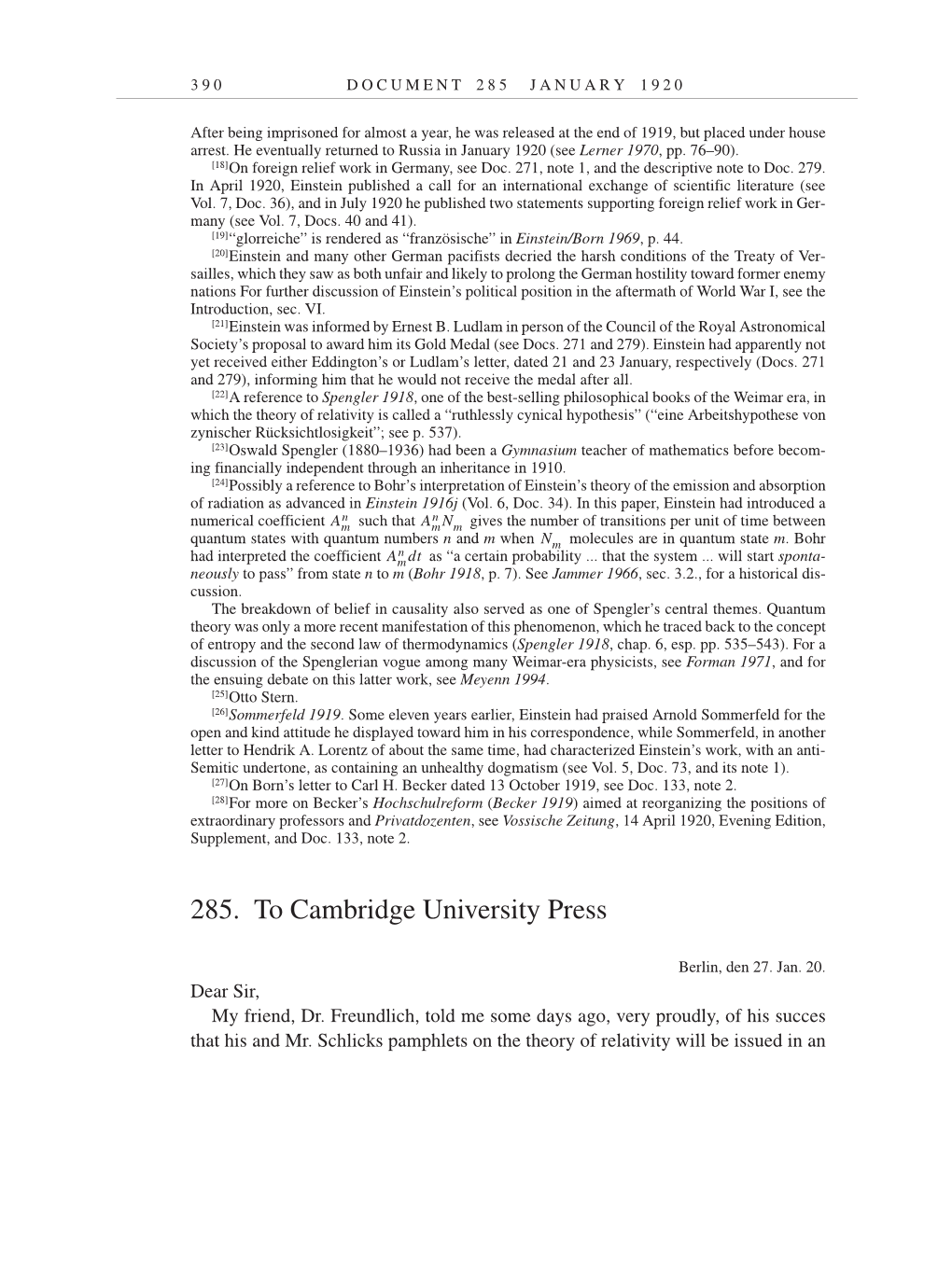3 9 0 D O C U M E N T 2 8 5 J A N U A R Y 1 9 2 0
After being imprisoned for almost a year, he was released at the end of 1919, but placed under house
arrest. He eventually returned to Russia in January 1920 (see Lerner 1970, pp. 76–90).
[18]On foreign relief work in Germany, see Doc. 271, note 1, and the descriptive note to Doc. 279.
In April 1920, Einstein published a call for an international exchange of scientific literature (see
Vol. 7, Doc. 36), and in July 1920 he published two statements supporting foreign relief work in Ger-
many (see Vol. 7, Docs. 40 and 41).
[19]“glorreiche” is rendered as “französische” in Einstein/Born 1969, p. 44.
[20]Einstein and many other German pacifists decried the harsh conditions of the Treaty of Ver-
sailles, which they saw as both unfair and likely to prolong the German hostility toward former enemy
nations For further discussion of Einstein’s political position in the aftermath of World War I, see the
Introduction, sec. VI.
[21]Einstein was informed by Ernest B. Ludlam in person of the Council of the Royal Astronomical
Society’s proposal to award him its Gold Medal (see Docs. 271 and 279). Einstein had apparently not
yet received either Eddington’s or Ludlam’s letter, dated 21 and 23 January, respectively (Docs. 271
and 279), informing him that he would not receive the medal after all.
[22]A reference to Spengler 1918, one of the best-selling philosophical books of the Weimar era, in
which the theory of relativity is called a “ruthlessly cynical hypothesis” (“eine Arbeitshypothese von
zynischer Rücksichtlosigkeit”; see p. 537).
[23]Oswald Spengler (1880–1936) had been a Gymnasium teacher of mathematics before becom-
ing financially independent through an inheritance in 1910.
[24]Possibly a reference to Bohr’s interpretation of Einstein’s theory of the emission and absorption
of radiation as advanced in Einstein 1916j (Vol. 6, Doc. 34). In this paper, Einstein had introduced a
numerical coefficient such that gives the number of transitions per unit of time between
quantum states with quantum numbers n and m when molecules are in quantum state m. Bohr
had interpreted the coefficient as “a certain probability ... that the system ... will start sponta-
neously to pass” from state n to m (Bohr 1918, p. 7). See Jammer 1966, sec. 3.2., for a historical dis-
cussion.
The breakdown of belief in causality also served as one of Spengler’s central themes. Quantum
theory was only a more recent manifestation of this phenomenon, which he traced back to the concept
of entropy and the second law of thermodynamics (Spengler 1918, chap. 6, esp. pp. 535–543). For a
discussion of the Spenglerian vogue among many Weimar-era physicists, see Forman 1971, and for
the ensuing debate on this latter work, see Meyenn 1994.
[25]Otto Stern.
[26]Sommerfeld 1919. Some eleven years earlier, Einstein had praised Arnold Sommerfeld for the
open and kind attitude he displayed toward him in his correspondence, while Sommerfeld, in another
letter to Hendrik A. Lorentz of about the same time, had characterized Einstein’s work, with an anti-
Semitic undertone, as containing an unhealthy dogmatism (see Vol. 5, Doc. 73, and its note 1).
[27]On Born’s letter to Carl H. Becker dated 13 October 1919, see Doc. 133, note 2.
[28]For more on Becker’s Hochschulreform (Becker 1919) aimed at reorganizing the positions of
extraordinary professors and Privatdozenten, see Vossische Zeitung, 14 April 1920, Evening Edition,
Supplement, and Doc. 133, note 2.
285. To Cambridge University Press
Berlin, den 27. Jan. 20.
Dear Sir,
My friend, Dr. Freundlich, told me some days ago, very proudly, of his succes
that his and Mr. Schlicks pamphlets on the theory of relativity will be issued in an
Am
n
Am
n
Nm
Nm
Am n dt
